Introduction
The burning heart of our fast cars, yeah you are right, I am talking about engine. It’s the power unit we have to spin our car wheels. The entire thrill we have got while driving depends on the capacity of this power unit, and the limits up-to which we can push its components to operate safely. It is the combination of all parts of an engine that makes a car to move faster and faster.
So let’s just dig out what it’s components are, and how precisely they must be engineered to get the maximum power out of an engine.
Main Parts of an Engine
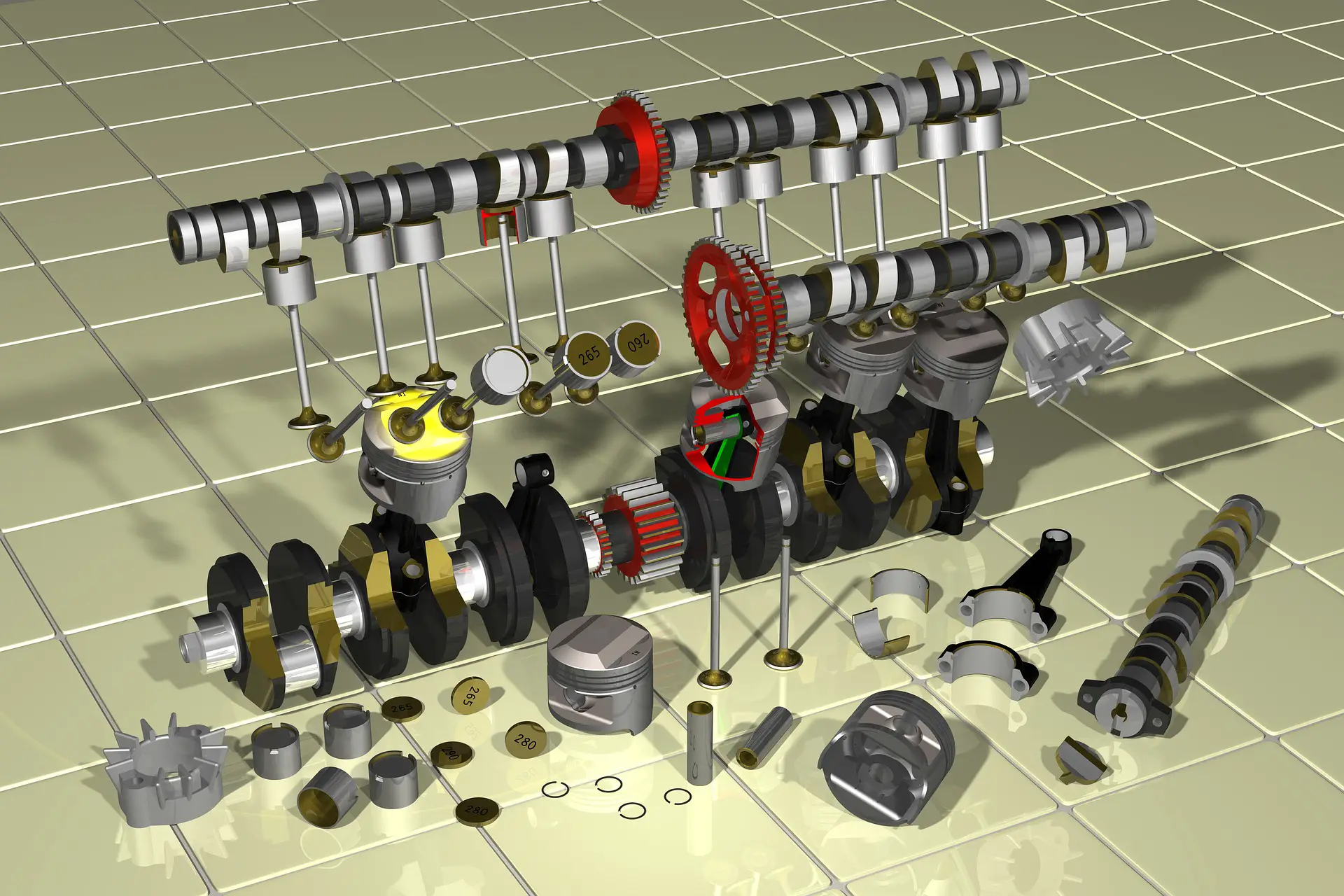
1. Engine Block
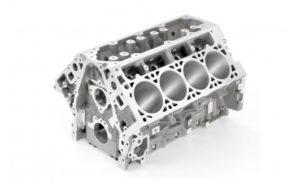
Engine block is an important parts of an engine. It is made by pouring the molten iron or aluminum alloy into a mold. The mold is made such that we should have required number of holes in the casted block, which are said to be the number of cylinders of an engine or engine cylinders. The diameter of these holes is called the bore of an engine.
We have some more holes along the length of engine cylinder, these are water and oil flow paths required for cooling and lubrication of an engine. Oil paths or vents are rather narrower than water flow vents.
What else we have in an engine block is semi-circular seats. On these seats half part of thrust bearings (thrust bearings come in two parts) are mounted, then we place the crankshaft in these thrust bearings. But we still need to hold the crankshaft to the engine block, to do that we have bearing-caps.
Bearing-caps have a semi-circular seat for other half part of thrust bearing. To mount the bearing-cap with engine block we use studs and nuts. One threaded end of stud goes into internal threaded hole in engine block, and other threaded end of stud goes into hole in bearing-cap and we fasten them together with nut. Two studs are used for holding one bearing-cap in place.
Now that we know that why we have semi-circular seats, in an engine block, let’s take a look what we going to do with cylindrical holes in the block.
2. Piston
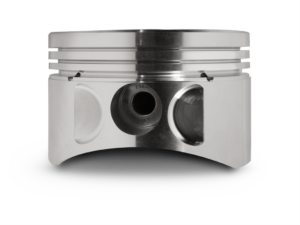
The piston is a cylindrical structure with a flat surface called a crown at the top. A piston is the component that moves up and down in an engine cylinder. Wait what it would cause?, friction if one cylinder (piston) moving up and down in another cylinder? Yeah to overcome this problem groves are made on the circumference of this cylindrical structure (piston). And we place rings in these groves called piston rings. So now the whole cylindrical structure is not rubbing with the engine cylinder and only piston rings are in contact with the engine cylinder thus reducing friction to a great extent.
Now how we go to use this up and down motion of the piston, for that we need to know about 2 more things that are connecting rod and wrist pin.
Also Read:
- What is Stirling Engine – Types, Mian Parts, Working and Application?
- How Engine Cooling System Works?
- Torque Converter Working, Principle, Main Parts and Application.
3. Connecting Rod
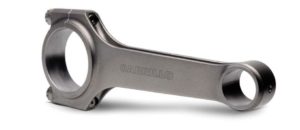
It is an ‘I’ shape structure whose one end is connected to the piston and the other one to the crankshaft. The piston side end of the connecting rod has a hole in it. And we have also got a hole in the piston’s cylindrical structure just beneath the piston rings. So we aligned this hole with a connecting rod hole and put a wrist pin through it. The wrist pin acts as a bearing and the connecting rod can move like a pendulum beneath the piston, though the piston’s cylindrical structure is gonna limit its motion. To make sure that the wrist pin does not move from its position it is restricted by the snap ring at both sides.
The other end of the connecting rod can be split into two parts. First is semi-circular journal bearing seat, which is placed over the crankshaft after installing the half part of the journal bearing, in the seat. The other half is journal bearing cap. These two parts are bolted together, holding crankshaft in between. Thus piston is now connected to the crankshaft through a connecting rod.
4. Crankshaft
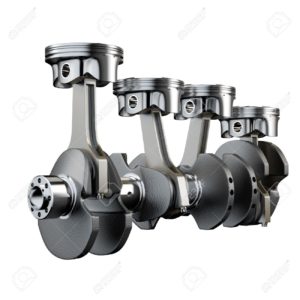
As the name suggests it is designed in such a way to convert the linear (up and down) motion of the piston into rotational motion. It works the same as the slider-crank mechanism. The material used for making crankshafts is cast iron but we also use forged steel in high-power engines where the load on the crankshaft is too high.
Casting a crankshaft seems to be an easy task, but it’s not. Once the crankshaft is cast it is then machined, which is not that easy considering its shape. Then after machining it requires proper balancing to work properly.
You will generally find some random holes in the crankshaft; these holes are for balancing the crankshaft while rotating at high speed.
5. Crankshaft Casing or Oil Sump
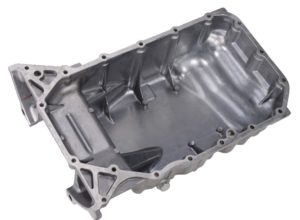
It is also called an oil sump. It is a casing which is bolted to the engine block, which covers the engine from the bottom thus called crankshaft casing. It retains lubricating oil in it which is pumped to different engine parts. The crankshaft has small holes that spill oil towards the piston, to remove piston heat and lubricate the piston rings, so it also prevents oil from splashing. We have got a bolt at the bottom of this casing from where we remove used lubricating oil during maintenance.
6. Engine Head
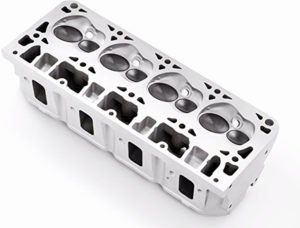
The engine head is cast in the same way as the engine block. Its mold is made such that the cast piece must have an opening for air to flow into the engine cylinder and an exhaust opening from where the burnt gases will go out. This passage of air flowing in and going out of the engine cylinder is controlled by inlet and outlet valves. So engine head also has cylindrical holes to insert the valve stem. Furthermore to burn the air-fuel mixture we have to fire it up and how are we gonna do that? Yeah, we need a spark plug which must produce a spark inside the engine cylinder, for this we need a cylindrical hole in the engine block to put a spark plug into the engine cylinder. We also have semi-circular seats cast in the engine head for camshaft bearings.
Before we discuss all the new terminology we have used to explain the engine block let’s just figure out how the engine head is attached to the engine block.
We have 4 internally threaded holes at the top of the engine block. The threaded end of the stud gets fastened up in the engine block and we have 4 studs fastened up in the same way in the engine block, then we put a gasket whose holes align with the engine block studs. We have 4 holes through the engine head and they align with 4 fastened studs of the engine block. This way we fasten the engine block and engine head with the gasket in between together with the help of stud and nut assembly.
7. Valves
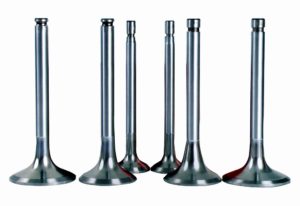
As we already know they control the inlet and exhaust air to go into and out of the engine cylinder. The material used to make valves is a nickel-chromium iron alloy. It can resist high temperature and have great strength. The valve could be described in two parts- valve stem and valve head. As we already know we have got cylindrical hole in the engine head for valve steam and we also have a valve seat where the valve head will rest in the engine head. The valve is mounted upside down means the valve head is facing the engine cylinder. It is so because when there is high pressure in the engine cylinder it would press the valve head against its seat in the engine head and thus pressure will be maintained at best.
Also Read:
- What is Firing Order of 4 and 6 Cylinder Engine?
- How Power Steering System Works? – Best Explanation
- Types of Gearbox – Complete Explanation
8. Camshaft
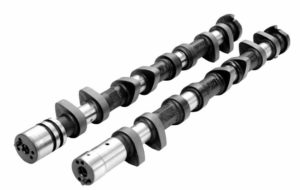
It is a shaft with a number of cam profiles along its length. So it regulates the valve opening and closing time. It does so by pressing the end of the valve stem by its cam profile. But we still need a mechanism that would return the valve back to its position once pressed by the cam profile of the camshaft. We have a valve spring and bucket head tappet assembly for solving this problem.
Now we have semicircular seats for the bearings of the camshaft. What retains it to be fixed in the engine head while rotating is cam-caps? They hold the other half of the journal bearing and have two holes in their casing through which we insert bolts and fasten them in internally threaded holes of the engine head thus we hold our camshaft between the casted journal seat in the engine block and cam-caps and fasten them up with long bolt.
9. Valve Spring and Tappet
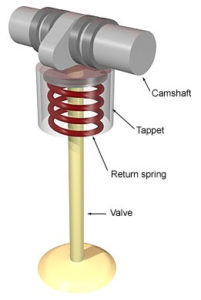
The valve spring provides a self-returning mechanism when the valve is not being pressed by the camshaft. We further have a bucket-type tappet covering the valve spring. The purpose of the tappet is to provide a smooth surface for the cam to press the valve spring or inlet and outlet valve. The arrangement is like we have valve spring around the valve stem and tappet mounted over that spring for a smooth surface and a camshaft mounted just over it making the valve move up and down using its cam profile.
10. Timing Belt
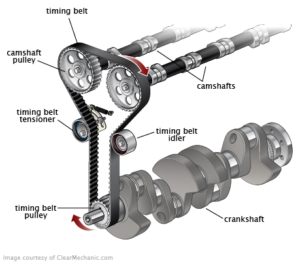
Wonder how the camshaft gets its rotational motion to regulate valves. Yeah, it’s through the timing belt which transmits the motion of the gear mounted at the crankshaft called crank-gear, to the gear mounted at the camshaft. The ratio of cam-gear to that of crank-gear is 2:1. So the camshaft would rotate only once in two rotations of the crankshaft. The timing belt is made up either from glass-fiber or Kevlar so it does not worn-out easily.
11. Spark Plug
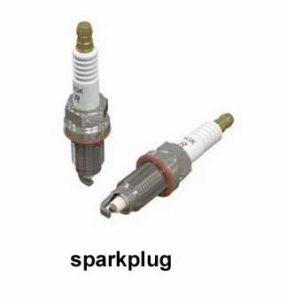
It is the parts of an engine that ignites the air-fuel mixture in the engine cylinder. It produces the spark at the right time by using the electrical energy of the battery. The basic working principle is that when we have high electrical potential at one end and zero or negative potential at the other end. And the two ends being very close to each other, it produces an electric field so strong between them that it ionizes the air molecules thus producing the spark. That is in the combustion chamber, It is made up of titanium so that it can withstand a real high temperature generated by high electric potential difference while producing spark.
12. Gasket
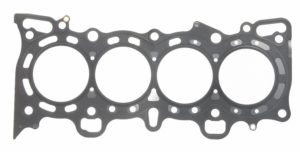
A wide variety of materials are used in making gaskets like Teflon, glass-fiber, silicon etc. It is generally a paper-like sheet which is placed between the engine block and the engine head. As we have already discussed that we have both water and oil vents in the engine block, so the gasket gives insulation from water or oil leaking into the engine cylinder or air-fuel mixture from the engine cylinder leaking out from the joint of the engine block and engine head. Aluminum engine blocks are preferred over cast iron because it expends more on heating thus compressing the gasket more, increasing the workability of the gasket, thus reducing the chances of leakage.
13. Piston Rings
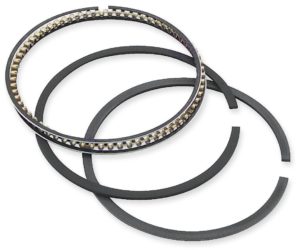
Yeah we have talked about them; they reduce friction between piston and cylinder walls. What else do they do?
Piston rings prevent the pressure created by the burning of air-fuel mixture from leaking into the crankcase. Not only that piston rings scrap down the oil from cylinder walls which is spilled by the crankshaft to remove heat from the piston. They also transfer heat of the piston to the cylinder walls which are being cooled by water circulation through water vents.
What You Must Know?
- In this article, we have discussed the petrol engine parts with overhead cam.
- In a diesel engine, all components are the same except the spark plug is replaced by the fuel injector.
- We have discussed the most basic parts of an engine excluding the auxiliaries like stator motor, oil pump, water pump etc.
